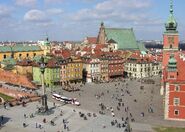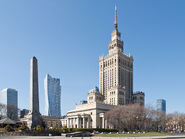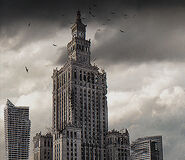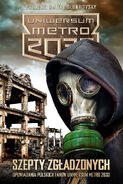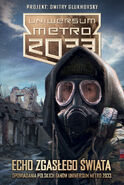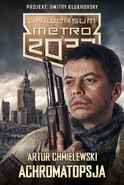Warsaw (Polish: Warszawa) is the capital and largest city of Poland. Artur Chmielewski's novel Achromatopsia, as well as several short stories from Whispers of the Fallen, Echo of an Extinguished World, and In Ruins all take place in Warsaw. The Vistula river flows through the city from north to south.
Aftermath of War
The bombs dropped on Poland's capital were quite small, yet numerous and all were detonated in the troposphere, resulting in a minimal shockwave with a maximal diffusion field of the so-called active material. For the city this meant relatively little physical destruction to its structures, but huge amounts of radiation. Moreover, many of the weapons utilized were of a bio-chemical nature, primarily affecting organic matter; in just hours animals and people died in immense torment as they turned into a fetid, muddy slush. Vegetation blackened and crumbled into dust, wood was transformed into a spongy toxic mass.
As a consequence of the atomic warfare, nuclear winter began to reign over Warsaw. Whenever the weather did warm up a little, anyone caught in the acid rain would experience serious injuries that burned all the way, through skin and flesh, down to the bone. The nuclear winter continued to cover the city's areas with ice and ashen snow even in the year 2033, with temperatures over a dozen degrees Celsius below zero. This in combination with the effect of the organic bombs led to a shortage of materials to burn for heating the hideouts of the few who manged to survive. In 2025, the discovery of an underground storehouse of coke near the station of Młociny helped immensely.
What has come to be known as Armageddon is said to have lasted only 45 minutes, however it wiped out the vast majority of the city's population. Those who were lucky enough to be travelling using the Varsovian Metro during this time managed to survive by staying beneath the surface of the earth. The sudden collapse of government and other institutions that people have become used to living with were followed by a period of chaos and infighting between the newly-forming factions of the Warsaw subway's inhabitants. Actors, famous journalists, celebrities, and businessmen were not let inside the metro by the rest of the surviving population, while politicians were exiled completely.
Outright warfare between groups living in the metro eventually stopped with the arrival of a new enemy from the outside - the grey-skinned, heavily mutated lifeforms of the surface, hungry for human meat. Although venturing above ground had always been dangerous due to the radiation and merciless winter, leaving the metro became synonymous with suicide for all but the most experienced of stalkers after the mutants appeared. What ensued from this was the formation of a Great Council of leaders from each station of the Varsovian Metro, which would meet periodically to discuss how to combat threats from the surface more effectively as well as solving Warsaw's internal affairs.
Varsovian Metro
- Main article: Warsaw Metro

Pałac Kultury i Nauki
The Warsaw Metro is home to thousands of survivors, their exact number unknown. The most powerful station in the metro is without a doubt Ratusz Arsenał, often referred to as "The Capital" of Warsaw's subterranean population, and the seat of every session of the Great Council. Ratusz Arsenał's domination is not hard to explain, because the main reason behind their power is the fact that they are the only faction in the metro with access to significant numbers of firearms and ammunition, having taken it from the police headquarters situated close to the entrance of their station above ground. The Capital also benefits from its somewhat central location in the metro, meaning that various trade caravans between north and south must pass through their territory.
Perhaps the second most important group is the large Radom Coalition of Wierzbno, Wilanowska, Służew, Ursynów, Stokłosy, Imielin, and Natolin stations in the south. The Radom Coalition is a considerably open-minded and liberal faction, perhaps partially due to the wise age of its female director. Kabaty, the southernmost station at the end of the Coalition, has fallen to massive attacks of mutated wildlife from the surface.
Świętokrzyska-2 (the lower level platform of the station) is colloquially known as "Vietnam" or "Little Asia", home to some of Warsaw's Vietnamese minority from the pre-war days. It has become a busy and efficient underground city of connected tin shacks, famous for its better food and untouchable thanks to its connections. The tunnel between Świętokrzyska and Ratusz Arsenał is the most well-maintained thoroughfare of the Warsaw Metro.
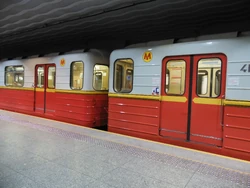
Trains running in the Varsovian Metro are modified versions of the same model that runs in the Moscow Metro
In the north, at Wawrzyszew and its surrounding tunnels live the bandits of football ultras from before the war, considered the most violent and primitive of the societies inhabiting the Varsovian Metro. Commanded by the middle-aged Mister Krupa, they form a military and political alliance with the New Vatican, at Plac Wilsona station, who are known for their apparent spirituality and shady dealings with the criminal underbelly of the metro.
Meanwhile, much further down south, are the Scholars living at Politechnika station - relied upon by the rest of the metro for most of the machines, equipment and expertise required to keep things running. Between them and the Radom Coalition is the central warehouse at Racławicka, a station headed by a young chief.
Once the metro's busiest station, Centrum is now nothing but a ruin since its ceiling collapsed during the bombardment of the city. The Palace of Culture and Science, not far from Centrum, is entwined in gigantic spiderwebs and nests of flying monsters. The tunnel between Nowy Świat-Uniwersytet and Centrum Nauki Kopernik is a terrifying zone that plays psychological tricks on those who attempt to pass through it, while the aforementioned CNK station has turned into a massive well due to flooding. The Vistula itself, at least near Warsaw, has frozen all the way from surface to riverbed.

Interior of a Warsaw Metro wagon
Across the river, isolated from the rest of the underground society, is Dworzec Wileński station of the M2 metro line - known as "Wileniak". It is ruled by a wise old woman called Sylwia Strzelecka, known as "The Empress". The lower level of Wileniak is partially flooded and serves as a farm for vegetables, where child labour is employed using kids that were born on the surface and thus affected by radiation poisoning. The denizens of Dworzec Wileński also use these children to help stop the station from being completely flooded by water entering from the previously sunken Stadion Narodowy station.
Ironically, above ground the National Stadium itself has remained almost untouched, and its white-and-red colours stand out from the monochromatic greyness of the post-apocalyptic capital. Efforts to settle the Warsaw Metro's unfinished Bródno station by the East-Varsovian Company on the M2 line are underway, but internal struggles between the factions involved get in the way of further development.
Denizens of the Varsovian Metro live mostly on mush made from protein processed from mushrooms with starch and other fillers mixed in; military rations and other preserved foods are considered a luxury. A popular beverage consumed throughout the metro is a mushroom infusion popularly named "tea".
Outskirts
Little is known about the outskirts of Warsaw, though some humans have survived there. In Ruins tells us about the shelter of the Varsovian Regiment that is located somewhere outside of the capital, where the legendary Captain Estera leads her militaristic expeditions to the surface and fights with some of the barbaric tribes that have formed nearby. In Achromatopsia, we learn about an advanced scientific complex and its mysterious masters at the "Owczarnia" in Emów.
Notable Characters
- Franz - an experienced stalker who leads the main characters of Achromatopsia as their guide on the mission to find the source of the distress signal.
- Unnamed Scholar - the protagonist and narrator of the same novel, whose name is never revealed in the book.
- Julia - female delegate of Imielin who joins the expedition along with Piotrek (male of similar age) from Stokłosy station.
- Dũng Nguyễn - commonly referred to as "Nguyen", the Vietnamese representative of the group.
- Captain Estera - a skilled stalker from the Varsovian Regiment on the outskirts of the city, who inspires her troops in battle against aggressive tribes of people living on the surface.
Trivia
- Despite Warsaw being the only city in Poland with a full metro system, it is not the sole or first Polish location in the Universe of Metro 2033.
- Warsaw became the capital of Poland in 1596, when King Zygmunt III Waza moved his court there from Kraków. It became the permanent seat of the General Sejm of the Polish-Lithuanian Commonwealth, a dualistic state of the Kingdom of Poland and the Grand Duchy of Lithuania.
- The city gained the nickname "Paris of the East" when decisions made by the country's last monarch, Stanisław August Poniatowski, led to many refurbishments, renovations, and entirely new constructions - resulting in Warsaw becoming a centre of culture and the arts in the late 18th century.
- Warsaw gained another nickname after World War II. Near the last days of the German occupation of Poland, after the fall of the Warsaw Uprising - the single largest military effort taken by any resistance movement during the Second World War - the capital faced a truly apocalyptic scenario as German forces raised the city to the ground through extensive bombing; over 85% of the area was destroyed and much of its population slaughtered, enslaved or displaced. Yet after the end of the war, Warsaw was rebuilt completely, restoring its role as the largest and busiest location in the country. It became known as the "City of the Phoenix", rising back from the ashes every time it falls, with twice the determination.
Gallery
| Locations of Post-Apocalyptic Eurasia | |
|---|---|
| Countries | |
| Capital Cities | |
| Cities & Towns | Astrakhan • Balashikha • Cheboksary • Kraków • Irkutsk • Novosibirsk • Polar Dawns • St. Petersburg • Vladivostok |
| Metro Systems | |
| Other Locations | Baikal • Caspian-1 • Caspian Sea • Ostankino Tower • Valley • Vistula • Volga • Volga Storage Facility • Yamantau Bunker |

